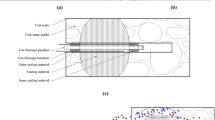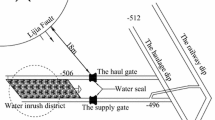Abstract
Considering the problems happening to sealing materials for hydraulic fracturing borehole in underground coalmines, such as shrinkage, poor sealing effect, high cost, and improper sealing length, a new hydraulic fracturing sealing material consisting of cement, early strength water-reduced agent, polypropylene fiber, and mixing water is under development. Through indoor laboratory experiment, the sealing material ratio at the optimum compressive strength and shrinking percentage is optimized. A mechanical model for hydraulic fracturing borehole sealing has also been established, which leads us to the relationship between the maximum water pressure that can be carried by sealing materials and such sealing parameters as properties of materials and sealing length. A proper sealing length is determined and verified through a site experiment. The result demonstrates that the optimal ratio of the new material is 1:0.6:0.03:0.005 for concrete, water, early strength water-reduced agent, and polypropylene fiber, respectively. The maximum water pressure that can be carried by the sealing material amplifies with the increase of the strength, elasticity modulus of the sealing material, and sealing length until a constant value is nearly attained when the sealing length reaches a certain point. In addition, taking Chongqing Songzao mining area in China for example, the reasonable sealing lengths of the fracture borehole for through beds fracturing and along beds fracturing are proved to be 10 and 13 m, respectively, which is consistent with theoretical analysis.











Similar content being viewed by others
References
Diaz Aguado MB, Gonzalez Nicieza C (2007) Control and prevention of gas outbursts in coal mines, Riosa-Olloniego coalfield, Spain. Int J Coal Geol 69:253–266
Fu X (2011) Study of underground point hydraulic fracturing increased. J China Coal Soc 36:1317–1321
Ge ZM, Yu CX, Wei Q (2012) Concrete admixture. Chemical Industry Press, Beijing, China
Guo HY (2011) Gas drainage theory and technology in underground coal mine based on hydraulic fracturing. Henan Polytechnic University, Jiaozuo, China
Hao ZY (2010) Research of composite technology and application in bored sealing. China University of Mining and Technology, Xuzhou, China
Hao ZY, Lin BQ, GAO YB (2012) Establishment and application of borehole sealing model in the spherical grouting model based on the loosing-circle theory. Int J Mining Sci Technol 22:895–898
Huang BX, Liu CY, Fu JH (2011) Hydraulic fracturing after water pressure control blasting for increased fracturing. Int J Rock Mech Mining Sci 48:976–983
Jeffrey RG, Weber CR, Vlahovic W, Enever JR (1994) Hydraulic fracturing experiments in the great northern coal seam. Proceedings of the SPE Asia Pacific Oil &Gas Conference, Melbourne, Australia, pp 361–371
Kakooei S et al (2012) The effects of polypropylene fibers on the properties of reinforced concrete structures. Constr Build Mater 27:73–77
Kang HP (1997) The theory of key circle of roadway surrounding rock. Mech Pract 19:34–36
Li F, Lin BQ, Zhan C (2012) Experimental study of new sealing material for hydraulic fracturing borehole. Saf Coal Mines 1:12–14
Lin BQ (2010) Theory and technology of gas prevention. China University of Mining and Technology Press, Xuzhou, China
Liu DJ (2006) Stability analysis and experimental study of hole wall in soil horizontal drilling. Jilin University, Changchun, China
Liu JJ (2008) Analysis and calculation on parameters of stress distribution of the front coal mining face. J China Coal Soc 33:743–747
Liu JX, Li ZQ, Li SH (2006) Coal roadway heading face outburst mechanism of hydraulic extrusion measure. J China Coal Soc 21:183–186
Lu YC (2010) Application the hydraulic fracturing technology in the high pressure and low permeability mine. J Chongqing Univ 33:104–106
Ni GH, Lin BQ, Zhai C (2013) Borehole sealed parameter measurement and analysis of pulsating hydraulic fracturing. J Chain Univ Min Technol 42:177–182
Ogilvie MT (1995) Gas drainage in Australian underground coal mines. Min Eng 47:50–52
Ouyang ZH, Qi QX, Zhang Y (2011) Mechanism and experiment of hydraulic fracturing in rock burst prevention. J China Coal Soc 36:321–325
Shen RX, Wang ZS, Cui YZ (2006) Fiber reinforced cement and fiber reinforced concrete. Chemical Industry Press, Beijing, China
Wang P, Mao XB, Lin JB (2009) Study of the borehole hydraulic fracturing and principle of gas seepage in the coal seam. Procedia Earth Planet Sci 1:1561–1573
Wang T, Zhou WB, Chen JH, Xiao X, Li Y, Zhao XY (2014) Simulation of hydraulic fracturing using particle flow method and application in a coal mine. Int J Coal Geol 121:1–13
Wright CA, Conant R.A (1995) Hydraulic fracture reorientation in primary and secondary recovery from low-permeability reservoirs. Paper SPE 30484 Presented at the 1995 ANNUAL Technical Conference and Exhibition, Dallas, TX, pp. 357 –369
Xu YP, Zhai C, Hao LS (2011) The pressure relief and permeability increase mechanism of crossing-layers directional hydraulic fracturing and its application. Procedia Eng 26:1184–1193
Zhai C, Hao ZY, Lin BQ (2011a) Research on a new composite sealing material of gas drainage borehole and its sealing performance. Procedia Eng 26:1406–1416
Zhai C, Li XZ, Li QG (2011b) Research and application of coal seam pulse hydraulic fracturing technology. J China Coal Soc 36:1996–2011
Zhai C, Li QG, Sun C (2012a) Analysis on borehole instability and control method of pore-forming of hydraulic fracturing in soft coal seam. J China Coal Soc 37:1431–1436
Zhai C, Lin M, Sun C (2012b) Guiding-controlling technology of coal seam hydraulic fracturing fractures extension. Int J Min Sci Technol 22:831–836
Zhang DL, Li ZG (2004) Analysis of borehole occluding system for tunnel curtain grouting in high pressure and rich water zone. Rock Soil Mech 25:1151–1154
Zhang GH, Wei GP, Hou FC (2007) Theory of start-split effusion stress and start-split location about through coal delaminaions’ bore of hydraulic fracture. J China Coal Soc 32:52–55
Zhang CJ, Leng YH, Li MP (2008a) Property studies and application of leak protection and flexibility of mekral on mud. Nat Gas Ind 28:91–93
Zhang L, Liu CY, Li ZH (2008b) Fit gas for foam fracturing in coal seam. J China Coal Soc 36:321–325
Zhang GJ, Zeng LX, Chen AZ (2012) Development and application demonstration of stemming slurry materials for high-pressure grouting in soft stratum. Chin J Geotech Eng 34:1109–1116
Acknowledgments
This paper is jointly supported by the National Natural Science Foundation of China (No. 51374258), the Chongqing University Postgraduates' Science, and Innovation Fund (No. CDJXS122411XX), Supported by Program for Changjiang Scholars and Innovative Research Team in University (NO. IRT13043).
Author information
Authors and Affiliations
Corresponding author
Rights and permissions
About this article
Cite this article
Ge, Z., Mei, X., Lu, Y. et al. Optimization and application of sealing material and sealing length for hydraulic fracturing borehole in underground coal mines. Arab J Geosci 8, 3477–3490 (2015). https://doi.org/10.1007/s12517-014-1488-6
Received:
Accepted:
Published:
Issue Date:
DOI: https://doi.org/10.1007/s12517-014-1488-6




